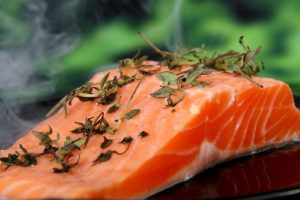Over the past decades, high fructose corn syrup has emerged as a better alternative to sugar. It’s found in thousands of foods, from cereals and fruit juices to low-carb chocolate and protein bars.
Your Step-by-Step Guide to the Ketogenic Diet

Your Step-by-Step Guide to the Ketogenic Diet
Are you tired of starving yourself and skipping meals to lose weight? What if you could get slimmer by eating bacon, eggs, and butter – without counting calories? Believe it or not, that’s possible. The answer is the ketogenic diet.
This slimming plan was initially prescribed in the treatment of epilepsy. It’s high in dietary fats, moderate in protein, and low in carbs. It requires no calorie counting or fancy meals. Plus, it works in as little as one week.
Today, the ketogenic diet is popular among athletes and fitness competitors. Even those who don’t exercise can reap its benefits. Let’s see how it works and if it’s really that healthy.
The Keto Diet at a Glance
This dietary plan has emerged as one of the best ways to lose weight and keep it off. It has been around for decades and provides fast results.
Think of it as the opposite of the standard American diet, which is high in carbs and protein. The keto diet encourages the consumption of fats, with moderate amounts of protein and little or no carbs.
Unlike most weight loss plans, it doesn’t require dieters to limit portion sizes and weigh their foods. In fact, you can consume as many calories as you want. The only condition is to keep your carb intake low and fill up on fats.
The keto diet works for so many people is because it targets the underlying causes of weight gain. By restricting carbs, it improves insulin response, balances your hormones, and prevents blood sugar spikes. Since its high in fats, it curbs hunger and keeps you full longer. As a result, you’ll eat less without even realizing it.
The best part is that you can enjoy delicious meals and high-fat foods that are banned on other diets. Popular keto recipes include:

- Avocado deviled eggs
- Fat bombs
- Cinnamon butter bombs
- Fried eggs and bacon
- Cauliflower mac and cheese
- Beef satay
- Baba ganoush
- Chocolate chia pudding
- Bacon guacamole balls
- Green bean casserole
- Fried pork chops
Sounds good, isn’t it? Unless you’re a carb addict, the keto diet is a great choice. Plus, its health benefits are backed up by research.
How Does the Ketogenic Diet Work?
Studies indicate that low-carb diets are the most effective for fat loss. In a clinical trial involving 132 severely obese subjects, those who went on a low-carb diet lost an average of 12.8 pounds in six months. The low-fat group dropped only 4.2 pounds.
According to a 2004 study, overweight patients with high cholesterol lost 20.7 pounds in 24 weeks. Additionally, their HDL cholesterol levels and triglycerides dropped significantly. Those who went on a low-fat diet lost only 10.6 pounds.
Compared to other low-carb diets, the ketogenic diet limits both protein and carbs. This causes the body to enter ketosis, a metabolic state in which it uses stored fat instead of sugar for energy. A high protein intake can throw your body out of ketosis. For this reason, it’s recommended to consume this nutrient in moderation.
Once in ketosis, your body takes its energy from ketone bodies in the liver. At the same time, it becomes more efficient at burning fat for fuel. When this happens, insulin sensitivity improves and mental acuity increases. In addition to fat loss, most dieters experience:

- Greater energy and stamina
- Mental clarity
- Loss of appetite
- Reduced sugar cravings
- Increased focus
- Enhanced exercise performance
However, ketosis has its drawbacks. Once you enter this state, you may experience the so-called keto flu for a week or two. Bad breath, fatigue, lethargy, migraines, and weakness are common side effects. However, these symptoms go away fast as your body adapts to its new source of fuel. After that, your energy will go through the roof.
What Are the Benefits?
Hundreds of studies confirm that the keto diet is far superior to other weight loss plans. It suppresses appetite and helps reduce food intake to a greater extent than high-protein, medium-carb diets. Plus, it lowers the risk factors for various disorders, such as diabetes, insulin resistance, metabolic syndrome, Alzheimer’s disease, epilepsy, and even cancer.
Research shows that more than half of epileptic patients who go on a ketogenic diet experience a 50 percent or greater reduction in seizure frequency. The same happens in up to 60 percent of children.
The keto diet not only promotes fat loss but also reduces inflammation. Sugar triggers an inflammatory response in the body and increases free radicals. Once you cut back on sugar, inflammation subsides.
Additionally, cancer cells use sugar as fuel. If you cut their food supply, your risk of cancer drops.
This dietary plan is also beneficial for diabetics. In a 2008 study, the ketogenic diet has been shown to reduce the need for diabetes medication, and even reverse the condition. It may also help prevent this disease by keeping your blood sugar stable and preventing insulin spikes.
Types of Ketogenic Diets
Before getting started, it’s important to know that the keto diet has several variations. The most popular ones include:
- The standard ketogenic diet, which limits carbs to 20 to 50 grams per day. Some dieters go as low as 0 carbs per day, while others can consume up to 80-100 grams without being kicked out ketosis.
- The targeted ketogenic diet, which limits carbs to 25 to 50 grams a day. The carbs must be consumed 30 minutes to one hour before exercise. This version is ideal for active people and athletes.
- The cyclical ketogenic diet, which involves eating little or no carbs for several days and carb loading for a day or two. This plan is popular among athletes as it allows them to replenish their glycogen stores and get the energy needed for training.
Other versions are the restricted ketogenic diet and the high-protein keto diet. Choosing one comes down to your needs. If you work out regularly or have an active lifestyle, the cyclical keto diet is your best bet.
What to Eat on the Ketogenic Diet
When planning your meals, make sure you’re getting at least 70 percent of your daily calories from fat. The other 25 percent should come from protein and five percent or less from carbs. For fast weight loss, try not to exceed 20 grams of carbs per day.
There is no ideal carb intake. Some dieters can go over 50 grams a day and still stay in ketosis. It depends on how carb-sensitive you are. Beware that if you consume too much protein, it’s going to be metabolized for energy. As a result, you won’t burn stored fat.
Your daily meals can include the following:

- Meat (ideally, grass-fed)
- Organ meat
- Fish and shellfish
- Butter
- Ghee
- Eggs
- Gelatin
- Any type of oil
- Avocados
- Mayo
- Sour cream
- Non-starchy vegetables (cucumbers, zucchini, asparagus, celery stalk, radishes, kale, spinach, leafy greens
- Unprocessed foods
- Berries in small amounts
- Garlic and onion
- Nuts and seeds
- Herbs and spices
- Water
- Coffee
- Herbal tea
- Electrolyte drinks
- Stevia
- Artificial sweeteners (aspartame, sucralose, sorbitol, xylitol)
- Coconut and coconut oil
- Olives
- Dark chocolate and raw cocoa
Beware that just because artificial sweeteners are allowed on this diet, it doesn’t mean they’re healthy. Aspartame, for instance, has been linked to neurological disorders. Saccharin may increase the risk of cancer. Ideally, stick to stevia, which is the only natural sweetener.
As a rule of thumb, ditch the sugar, root vegetables, beans, legumes, grains, starches, and sugary beverages. Berries and avocados are the only foods allowed, but only in small amounts.
Avoid diet foods and sugar-free foods because they may affect ketone levels or contain hidden sugars. For example, sugar-free chocolate is often high in carbs, so it can throw you out of ketosis. Instead, opt for dark chocolate with at least 80 percent cocoa.
For a quick boost of energy in the morning, add a tablespoon of butter or coconut oil to your cup of joe. This will keep you full longer and help you enter ketosis faster.
Replace your go-to snacks with chicken wings, avocado, fat bombs, and homemade high-fat treats. Steer clear of smoothies and fruit juices. Protein shakes are fine as long as they fit into your macros. Just make sure you check the carb content.
Is the Ketogenic Diet Right for You?
If your goal is to lose weight fast, the keto diet will do the trick. Be prepared for the flu-like symptoms that are likely to occur in the first 7-14 days. Sip on electrolyte drinks and eat more fats to make this transition easier. Magnesium and potassium supplements can help.
Addicted to carbs? No problem! Once you start this diet and enter ketosis, your cravings will become less intense. Plus, you can try the cyclical ketogenic diet, which is more flexible. For instance, you go low carb for five days, increase your carb intake and cut back on fats over the weekend, and then start all over.
The ketogenic diet is one of the few weight loss plans that really work. It does require discipline and willpower, but it’s worth the effort. Try it yourself – the results will surprise you!









No comments yet.